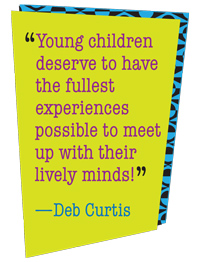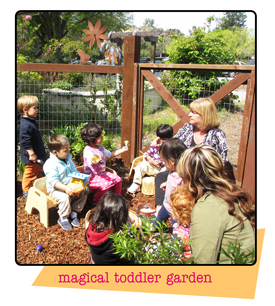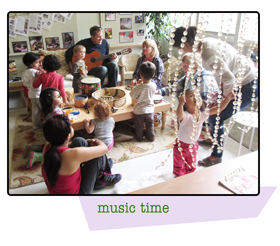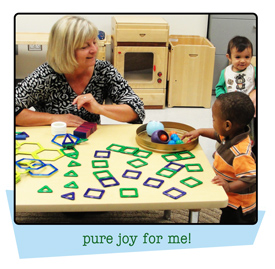Deb Curtis and Margie Carter
Published: 2012
Margie Carter and Deb Curtis are the dynamic partnership behind many of your favorite books, from Designs for Living and Learning to The Visionary Director, Second Edition. For more than twenty years, Deb and Margie have been inspiring early childhood professionals around the world together—they’ve designed and taught college courses, worked side-by-side with classroom teachers, produced professional development videos, presented at conferences, consulted at centers, and coauthored seven books. Read on to learn about their writing process, why they think observing children is such a unique and powerful teaching tool, and what they hope you’ll take away from their latest book, The Art of Awareness, Second Edition.
How have you worked as writing partners over the years?
Margie Carter
Our working partnership has evolved over the last twenty years and passed through several phases. In the early years of working together, I was so excited about finding a soul mate who viewed children and teaching in such a similar way. We had so much fun playing together, both out in the world and in our writing. Our first book, Training Teachers, was written in the early days of personal computers and we literally sat side-by-side as we worked out what we wanted to say and how to organize it.
Our books have all come out of our working in the field with a particular set of ideas we were exploring. After a few years of what might be thought of as “field testing,” we would find ourselves confident enough that we had some new things to contribute in a book. Many of our early books were written in the cracks while we were holding down fulltime jobs and traveling to consult and present. This was always challenging, but Deb’s playful spirit always kept us loving our work together.
As our travel schedule intensified over the years, we naturally started to discover more of our differences. I tend to start with ideas that I’ve been researching and chewing on, whereas Deb starts from concrete stories and experiences to weave her way to the ideas. These differences further intensified when Deb gave up her college teaching and returned to work directly as a children’s teacher and I started working more with administrators. Sometimes our differences led to fierce struggles, but in the end, they’ve always made our work richer and resulted in more growth for each of us. Deb has an infectious way of getting everyone around her excited about the details of children’s remarkable activities.
Deb Curtis

My partnership with Margie has been one of the most rewarding relationships in my life. Margie is a powerful person who has made a huge difference in my life and in the early childhood profession. From the beginning, we shared many similar ideas and values and we had a great time “playing” and inventing new ways to provide experiences for children and teachers. We have been learning together the entire time, through great experiences with other professionals, through writing together, and during intense, engaging discussions where we supported and challenged each other to deeper understandings of our work and ourselves. We have been willing to stick with our partnership through the many joys and struggles. Because we have seen the value of our rich collaboration for thinking and learning, we now strongly advocate for reflection in communities of practice as a powerful professional development tool for all educators. We have come to understand that there is nothing better for transforming our work than having friends and colleagues to think with, question, challenge, and support through the complex experiences of teaching and learning.
What are you both doing these days?
Deb Curtis
I have given up my work with adults for now, as I am spending my days as a toddler teacher at Crescent Park Child Development Center in sunny Palo Alto, California. I’ve been telling people that I don’t like weekends because they keep me away from the children for too long. Being with toddlers engages me intellectually, emotionally, and spiritually. I love to document and write about the remarkable things I see children do and the new insights I discover about learning and development. I have studied children’s development—particularly what’s happening with their brains—for a while now and to see the theory unfold before my eyes is exciting and inspiring. I am eagerly studying how my practices with the children can catch up with all we have come to understand about them in the last ten years. Young children deserve to have the fullest experiences possible to meet up with their lively minds!
Margie Carter

With Deb giving up traveling for work and the arrival of my 70th birthday, I’m trying to slow down and focus more of my time in my own Seattle community. We have handed over our little non-profit training organization, Harvest Resources Associates, to be managed by our fabulous colleagues Wendy Cividanes and Debi Lebo. They, along with a cadre of associates with whom we’ve worked over the years, continue to do the work of promoting vibrate child-centered practices and administrative systems which support teachers to meet up with children’s hearts and minds. I jump in and participate in some of the Harvest Resources Three Day Institutes focused on reflective teaching practices and—for directors and education coordinators—moving from being an administrator to an innovator. I have also been leading small study tours to New Zealand where we gain inspiration and learn from their exemplary early childhood system. You can keep track of our institutes and study tours at www.ecetrainers.com. Finally, writing and mentoring diverse leadership is a contribution I still want to offer our field. Deb and I both regularly write for Child Care Exchange and we are steadily revising our books published by Redleaf, the latest of which is a second edition of The Art of Awareness.
What inspired you to write The Art of Awareness?
Margie Carter
Teachers and family providers have so many expectations to contend with—from the children, families, regulators, and desired learning outcomes. As a side-by-side coach in their classrooms and an instructor in college settings, I discovered teachers tend to focus more on their schedules and routines than on the children themselves. What a loss for everyone involved! In The Art of Awareness, we wanted to alert early childhood educators to another possibility, a way of working that is far more enjoyable and ultimately valuable.
Deb Curtis
I have been working with young children for a long time and I’ve come to realize that the nature of the work makes slowing down to truly be with children difficult. There are ongoing chores of cleaning up, planning, communicating with families, and the growing pressures to prove that children are learning when they are with us. In my own work with children and teachers, I’ve seen that these pressures compete for our attention, making it difficult to keep children at the center of our work. Most of us go to work with young children because we love their view of the world and want to share it with them. Yet with all of the demands, we must work intentionally to find ways to stay present with children. We wrote The Art of Awareness because we know that really seeing children in the midst of our busy days takes time and practice. We didn’t want to focus on the traditional, often sterile, approaches to observing children. Instead, we worked to invent new ways to be in the world with children, seeing the details of their amazing ways and sharing in the joy and wonder of exploration and discovery.

How have your own lives and professional development been enhanced by observing children?
Deb Curtis
I have been inspired in so many ways by observing children. I have come to understand that children see the world in a very different way than I do. They actually hear, see, and experience more than I do. They are better at learning than I am, and when I pay close attention and try to put myself in their shoes, I get a glimpse of the richness of the world that I had forgotten. My observations have also led to a deeper understanding of the innate desires and skills that children are born with which enable them to forge deep connections and friendships. Seeing children grow relationships with each other, their families, and me gives me hope for the future of humans working together on the earth.
Observing children and sharing the stories of what I see has also enhanced my work with teachers and parents. Adults are inspired by the details of children’s perspectives. I have found that helping others see children and their competencies is one of the most powerful approaches for transforming teaching and parenting practices and encouraging people to live more joyful lives.
On a practical level, observing children and really coming to know them has helped me become a better teacher. I’m able to respond thoughtfully in the moment and plan a fabulous environment and materials that the children love and learn from. The children in my group can’t wait to be there everyday—and neither can I!
Margie Carter
You know, I don’t think I could have continued to grow and stay in the ECE field if I hadn’t been captivated by watching children at play. The professionalization of the early childhood field has moved us away from delighting in children’s play, instead, focusing us on standards and learning outcomes. I couldn’t teach children today if that was my only focus. But when you give children opportunities to engage in rich play experiences and arrange your room and teaching team so that you can observe what is unfolding, you’ll see how those desired outcomes are emerging.
Beyond my professional learning, I think observing children has helped me develop a more curious mind in general. Children remind me of how important it is to be imaginative, something we desperately need to find our way through this troubled world. I find myself more able to be in the moment when with my grandchildren and each time I step into an early childhood program.

What do you hope early childhood professionals will learn and do as a result of reading this book?
Deb Curtis
My hope for The Art of Awareness, Second Edition, is for you to learn to slow down and really see children. I hope you will let go of your agendas for what you need to do for children or get them to do—even for just a few moments, to delight and be curious. I hope you will see your work as ongoing, exciting research where you can’t wait for the next surprise or discovery by children and you! And that you will share the stories of your observations to advocate for children’s right to a rich, long childhood!
Margie Carter
I really want you to fall in love with children and to be amazed by how competent they are. Becoming a more aware educator will help you work with more intention. Working and living with more intention means you are taking charge of your life, despite any hardships.
Our lives are so busy and rushed that we easily overlook what children can offer us in the way of really noticing what’s around us. Trying to see the world as children do is a great anecdote to living with the habits and stress that fill our days.

Learn more and see a full list of titles by Deb Curtis and Margie Carter.